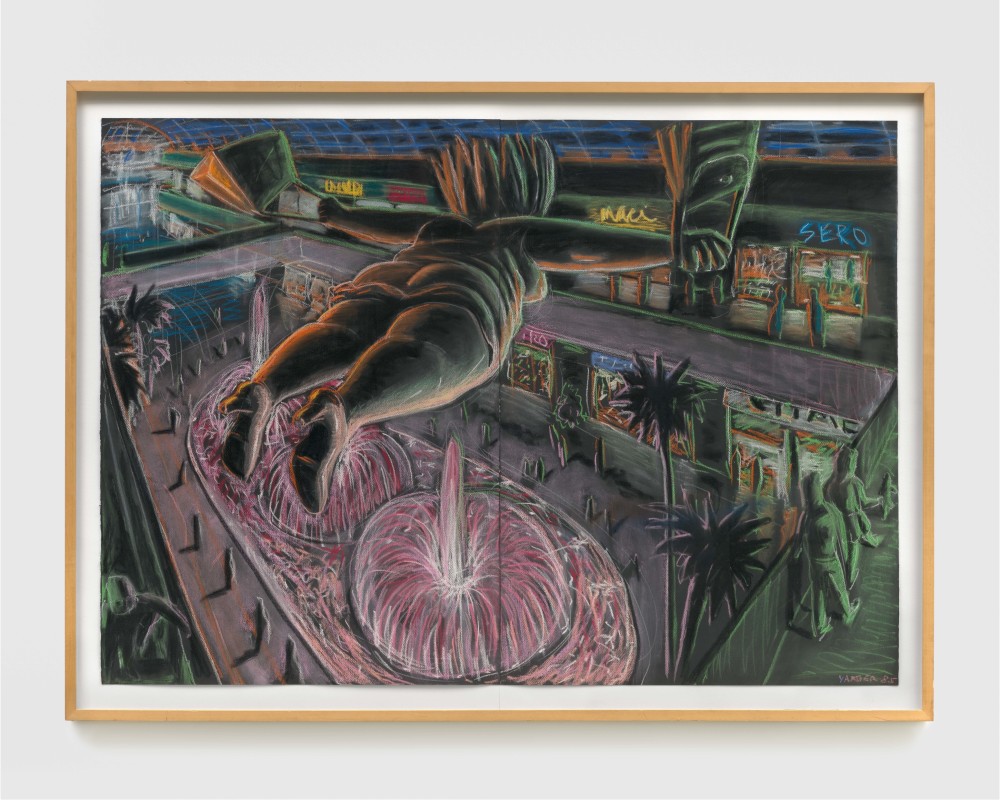
Remain in Light: Tomas Harker / Laurent Proux / Robert Yarber
REMAIN IN LIGHT is an ouroboros of the day-night continuum, a study of flesh-in-light as it reflects, refracts, and reframes the sun and elements in the daytime, the city’s ambient and aggressive streetlights and neons in the night, and the ecstatic, throbbing strobe on indoor creatures and cretins ambivalent to whether the day is breaking or falling.
Each of the three featured artists occupies his own fraction of the cycle: Laurent Proux’s human figures are beasts of the daylight. They engage in polyamorous union with the ground, the flora, and the sun in orgies of limbs, light, and landscape. Proux’s sun both blinds and illuminates the erotically charged ongoings, while the other subjects radiate their own energies outward in playful opposition.
Robert Yarber’s city nightscapes parlay both the absence of natural illumination and the way certain characters come to higher or lower consciousness under neons and fluorescents. The physics behind his falling or flying figures are built upon morals and ethos of subterranean origin, but it takes a certain flavor of glow to bring them out. Yarber’s depictions of night life are defined by the way light of artificial origin dominates certain figures into precarious situations.
Finally, Tomas Harker’s visions of 1990s rave culture exist almost outside of time and memory itself, though decidedly in places the sun can’t reach. His renderings have a granulated quality, as if the viewer is watching on a VHS tape, but the pulse of the strobe cast back from bodies in the peaky throes of music and chemicals is unmistakable. The revelations felt on Harker’s Saturday night will be repented Sunday morning.
Tomas Harker (b. 1990, United Kingdom) lives and works in London. His works addresses the nature of meaning in conditions of mediated experience and hyperreal saturation. Harker’s practice often draws from a variety of image production and distribution systems in an attempt to make sense of a cosmic order becoming increasingly disordered. His paintings reflect the increasing murkiness and confusion of contemporary life, whilst remaining mindful of the dynamics of power benefiting from uncertainty. Exhibitions include Remain in Light: Tomas Harker, Laurent Proux, Robert Yarber, Nicodim, Los Angeles (2025, forthcoming); The Lightness of Being, Nicodim Annex, Los Angeles (2024, solo); Multiple Choice Fairytale Ending, The Sunday Painter, London (2023, solo); New Ancients, Guts Gallery, London (2023); The Artist is Present, Guts Gallery, London (2022); Apotrope, Cob Gallery, London (2022); I haven’t been Sleeping, Screw Gallery, Leeds (2021, solo); Bloomberg New Contemporaries, South London Gallery, London (2021); Third Nature, Copeland Gallery, London (2021, solo); A Sea in Suspense, Bo.lee Gallery, London (2019, solo); There’s something about Painting, Tatjana Pieters, Ghent (2019); Cite, Bo.lee gallery, London (2018); and Syzygy, Leeds Arts University, Leeds (2018).
Laurent Proux (b. 1980, Versailles, France) lives and works in Paris. He is known for his large-scale, expressive works that explore the tension between industry, nature, and the human experience in the context of 21st-century late capitalism. His work raises questions about the relationship between the body and its environment, reflecting on labor, identity, and the forces of nature. Exhibitions include: L’arbre et la machine, Musée de l’Abbaye, Saint-Claude (2025, solo, forthcoming); Remain in Light: Tomas Harker, Laurent Proux, Robert Yarber, Nicodim, Los Angeles (2025, forthcoming); I’d put you in a mirror, GNYP Gallery, Berlin (2024, solo); Les chambres de verre - artistes de la Casa de Velázquez, Académie des Beaux-Arts, Paris (2024); Rendez-vous, peinture contemporaine en France, Belgrade City Museum, Belgrade (2024); Licked by the Waves | New Bathers in Art, MORE Museum, Gorssel (2024); Second Nature, Semiose, Paris (2024); Le jour des peintres, 80 peintres contemporains de la scène française, Musée d’Orsay, Paris (2024). Sunburn, Semiose, Paris (2023, solo); All Walks of Life, Pace Gallery, Hong Kong (2023); Secrets in the Clouds, The Cabin, Los Angeles (2022, solo); Lost In A Spectacle, curated by Sasha Bogojev, Woaw gallery, Beijing (2022); Salt, Tinimini Room, Dordrecht (2022, solo); En sí, para ti, más allá, curated by María Santoyo, Institut français de Madrid, Madrid (2022); Soft Grass, Semiose, Paris (2021, solo); Chicago Drawings, Mana Contemporary, Chicago (2019, solo); Jungle Métallique, Lieu-Commun, Festival: Le Printemps de Septembre, Toulouse (2018, solo); and Line-Off Ceremony, Semiose, Paris (2017, solo).
Collections include: National Center for Visual Arts (CNAP); the FRACs of Occitanie, Limousin, and Nouvelle-Aquitaine; and the Paris Municipal Collection (FMAC).
Robert Yarber (b. 1948, Dallas, Texas) lives and works in central Pennsylvania. Since the 1970s, Robert Yarber has produced mind-bendingly psychedelic paintings, first gaining international acclaim when his work was included in “Paradise Lost/Paradise Regained: American Visions of the New Decade,” an exhibit organized by the New Museum for display in the American Pavilion at the 41st Venice Biennale in 1984. Yarber gained further prominence with his inclusion in the 1985 Whitney Biennial, and he is credited as a major influence for the art direction of Terry Gilliam’s 1998 film Fear and Loathing in Las Vegas.
Yarber has exhibited nationally and internationally since the early eighties. Exhibitions include Remain in Light: Tomas Harker, Laurent Proux, Robert Yarber, Nicodim, Los Angeles (2025, forthcoming); Anamorphic! Sublime!, Galeria Nicodim, Bucharest (2019, solo); Return of the Repressed, Nicodim Gallery, Los Angeles (2018, solo); Panic Pending, Reflex Amsterdam, Holland (2014, solo); Calaveras Gnosticos, Sonnabend Gallery, New York (2009, solo); Sortie: The Demonological Survey, Kyungpook National University Art Museum, Daegu (2007, solo); and Robert Yarber, Sonnabend Gallery, New York (1998, solo). His works can be found in the collections of Whitney Museum of American Art, New York; The PaineWebber Art Collection, New York; The Broad Museum, Los Angeles; and The Museum of Fine Arts, Boston, among others.